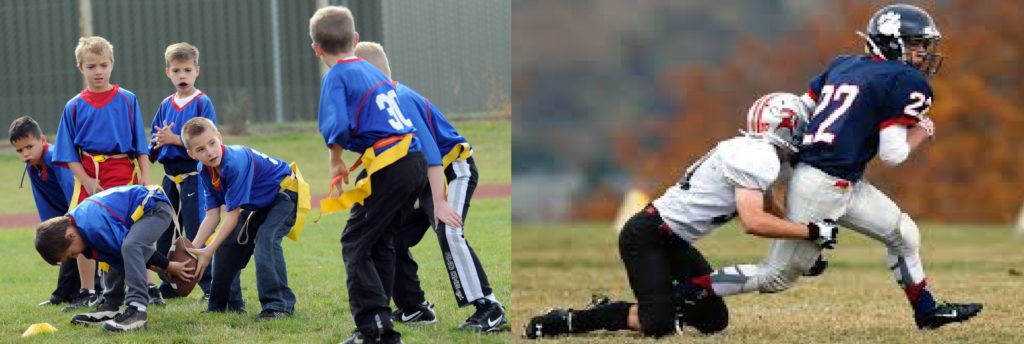
Introduction
Youth football stands as a cornerstone for budding athletes, fostering teamwork, discipline, and sportsmanship while honing their athletic skills. Among the myriad of youth football programs, two distinct variations stand out: flag football and tackle football. Despite sharing the core tenets of the game, these variations diverge significantly in terms of gameplay, regulations, and safety protocols. This essay explores the differences between youth flag football and tackle football, highlighting their unique characteristics, advantages, and considerations for young players and their families.
Gameplay and Structure
Flag Football
Flag football eliminates the physicality inherent in tackling. Players wear belts with flags, and opponents must strip these flags to stop ball carriers. The absence of tackling fosters a dynamic, agile style of play. Strategies focus on evading defenders, executing precise passes, and strategic positioning.
Tackle Football
Tackle football embraces physical contact as a core aspect of the game. Players wear helmets, shoulder pads, and other protective gear to mitigate injury risks. Tackling is the primary method of stopping ball carriers and securing possession. The gameplay emphasizes blocking, tackling techniques, and structured formations.
Safety Considerations
Flag Football
Flag football significantly reduces the risk of severe injuries associated with tackling, such as concussions and fractures. Players develop fundamental football skills without exposure to high-impact collisions. The focus is on agility, speed, and strategic acumen over physical dominance. It is ideal for introducing younger players to the sport in a safer environment.
Tackle Football
Tackle football inherently involves physical contact, increasing the risk of injuries. Concussions, sprains, and fractures are common concerns, especially among youth players. Adherence to safety protocols, proper coaching, and technique instruction are crucial for minimizing injury risks. The physical demands require comprehensive conditioning and strength training programs.
Skill Development
Flag Football
Flag football emphasizes fundamental skills such as passing, catching, and route running. It promotes strategic thinking, teamwork, and adaptability on the field. Players develop agility, speed, and spatial awareness in a less physically demanding setting. It is ideal for players looking to refine their football fundamentals before transitioning to tackle football.
Tackle Football
Tackle football allows players to hone tackling, blocking, and physical skills under controlled conditions. It fosters resilience, mental toughness, and camaraderie among teammates. Players learn complex offensive and defensive strategies. Achieving excellence requires commitment to strength training, conditioning, and skill refinement.
Accessibility and Participation
Flag Football
Flag football is often seen as more accessible and inclusive, transcending barriers related to size, strength, and physicality. It welcomes players from diverse backgrounds, skill levels, and physical abilities. Minimal equipment requirements enable play in various settings, including parks, schools, and recreational leagues. It encourages participation among children who may be apprehensive about contact sports.
Tackle Football
Tackle football is traditionally viewed as a more conventional and competitive form of the sport. It demands significant commitment in terms of time, resources, and parental involvement. Participation can be influenced by concerns about injury risks and long-term health implications. Structured within formal leagues and organizations, it prioritizes skill development and competitive success.
Long-Term Impact and Career Aspirations
Flag Football
Flag football serves as a gateway for players to explore their passion in a less physically demanding environment. It offers avenues for skill enhancement, teamwork, and leadership that transcend sports. It can be a recreational pursuit or a stepping stone for players transitioning to tackle football or other competitive sports.
Tackle Football
Tackle football provides a pathway to higher levels of competition, including high school, college, and potentially professional leagues. Pursuing competitive aspirations requires dedication, perseverance, and sacrifice. It raises considerations about the long-term health impacts of a physically demanding sport. It imparts invaluable life lessons in discipline, resilience, and teamwork that extend beyond the football field.
Conclusion
Youth flag football and tackle football represent two distinct yet interconnected facets of the sport, each offering unique advantages, challenges, and opportunities for young athletes. While flag football prioritizes safety, skill development, and accessibility, tackle football emphasizes physicality, competition, and long-term aspirations. The choice between flag and tackle football depends on individual preferences, aspirations, and considerations for safety and well-being. Regardless of the chosen path, both variations enrich the fabric of youth sports, shaping the experiences and aspirations of young athletes for generations to come.








